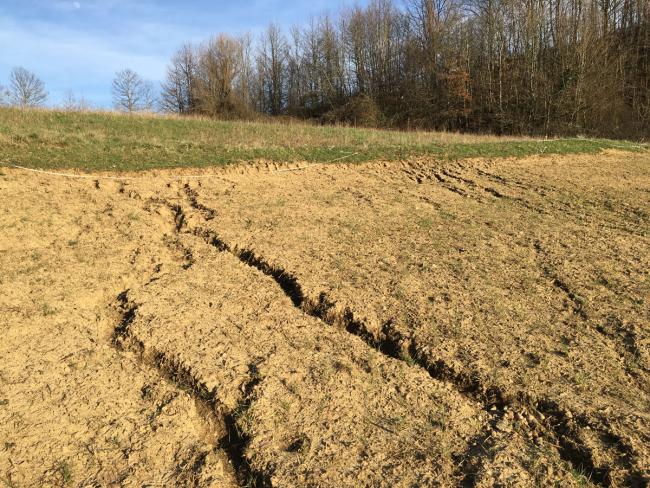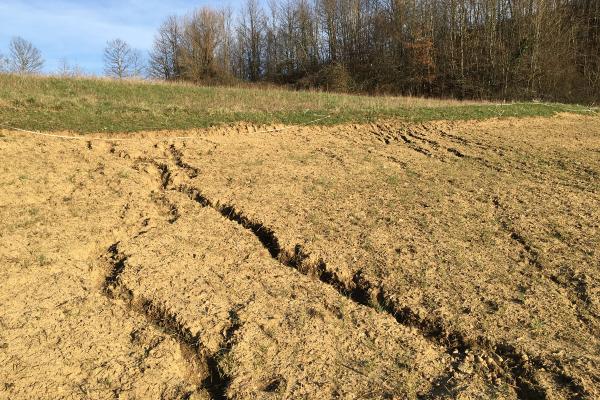Solutions to reduce soil erosion in hilly and mountain areas maintaining and enhancing agricultural activities

SOiLUTION Project objectives are: - Soil erosion reduction in hilly and mountain areas; - Introduction of conservation agriculture technique in hilly and mountain areas (based on improved crop rotation, use of cover crops, no tillage systems)
SOiLUTION work plan includes three work packages: WP1 will be focused on introducing and adapting conservation agriculture practices (including cover crops) on farms located in hilly and mountain areas. WP2 will test several cover crops in the same farms to identitìfy the best ones for hilly and mountain areas. WP3 will carry out a multi-criteria analysis assessing the benefits achieved through the adoption of conservation agriculture practices in hilly and mountain areas.
In the mountain and high hill areas, the abandonment of farms due to the gradual loss of competitiveness, is a very frequent phenomenon. This has a major impact on land management and landscape protection. The recovery of agricultural land, maintaining and possibly facilitating the return of people to areas where populations are dwindling will be achieved by facilitating the access by operators to the market segments in which it is valued the commitment to quality, and by increasing biodiversity through the introduction of new species/varieties best suited to be used both as cover crops and/or for new productions.
Conservation Agriculture (CA) is an approach to managing agro-ecosystems for improved and sustained productivity, increased profits and food security while preserving and enhancing the resource base and the environment. CA is characterized by three linked principles: Continuous minimum mechanical soil disturbance; Permanent organic soil cover;
Diversification of crop species grown in sequences and/or associations. CA holds tremendous potential for all sizes of farms and agro-ecological systems, but its adoption is perhaps most urgently required by smallholder farmers, especially those facing acute labour shortages.
WP1 will be focused on introducing and adapting conservation agriculture practices (including cover crop) on farms located in hilly and mountain areas.
The aim of this action is to introduce conservative farming in hill and mountains in order to enrich soil organic matter and to reduce erosion.
The expected results are the development of a conservation agriculture model, which will be summarized in a document outlining “Good Practice of Conservation Agriculture".
The introduction of new species/varieties best suited to be used both as cover crops and/or for new productions will positively affect the cultivated biodiversity.
In WP1 conservation agriculture practices (including cover crop) have been introduced in the partner farms (members of the Operational group OG) located in hilly and mountain areas.
Experimental fields were composed of 2.000 square meter large plots divided in half: one half was managed following the classic agronomic techniques and rotation practiced by the farmer, while the other half was managed introducing cover crop, using minimum tillage instead of deep ploughing and diversificating the crop species grown in sequence.
WP1 objective was to measure the capacity of the new introduced practice to enrich soil organic matter, reduce erosion, improve cultivated biodiversity and finally give benefit to the farmer.
Field experiments have been badly affect by severe weather conditions and crop damages by wild animals which hit in particular high value crops (for those areas) like potato and pumpkin.
Experiment results show as, after only two years of minimum tillage and cover crops, the main parameters of chemical, physical and biological fertility of the soil are improving, although the differences with conventional management in most cases are still not statistically significant. Moreover significant savings are achieved in terms of non-renewable energy consumption, even in farms not well equipped.
The aim of WP2 is to evaluate the suitability of some cover crops as green manure in crop rotation in hilly and mountainous areas. For this purpose the ability of different cover crops to adapt to hilly and mountain areas will be evaluated as well as their biomass production.
The expected results are the spreading of cover crops use in hilly and mountain areas with the following benefits:
- to improve soil structure (the roots of the cover crop will also help to improve soil structure. The foliage of the plants helps to prevent compaction of the soil by protecting it from rain, erosion and, in some cases, livestock);
- to prevent erosion (ground that is exposed to the elements is at a greater risk of erosion by wind and water runoff. Cover crops help to stabilize the soil, prevent runoff and both binding the soil together and improving its structure);
- to increase organic matter (cover crops add to the organic matter of the soil, both when living as leaves drop to the floor, and when slashed or allowed to die back, when they form a natural mulch or compost);
- biofumigation (some plants, from brassicaceae family, contain organic compounds called glucosinolates. When the tissues of these plants are damaged, biologically active chemicals are produced. One of the most important compounds released is isothiocyanate which has biocide activity).
In WP2 experiments in small parcels to test cover crops have been carried out for two consecutive years. The fields were located in two partner farms in hilly and mountain areas. The aim of WP2 was to evaluate the adaptability of 10 types of cover crops to hilly and mountain areas. The cover crop tested were: Horseradish; Spinach; Clover (2 different varieties); Field Bean; Mustard; Field Bean + Barley; Phacelia + Barley; Pea + Barley; Vetch + Rye; Oat + Vetch + Pea.
In none of the tests carried out the cultivated cover crops have reached a sufficient development for the purpose for which they were grown. The causes were mainly climatic and have to do with the intense winter cold during the first year and the extreme autumnal drought in the second. The cover crops used in purity and mixed in the tests have shown in the two years of experimentation the inability to develop
in the typical conditions of mountain areas due to environmental conditions. For this type of environment it is necessary to find more resistant species and varieties and to anticipate as much as possible the sowing so that they reach the first cold in a sufficient development stage.
A multi-criteria analysis will be carried out in WP3 in order to assess the benefits achieved through the adoption of conservation agriculture practices in hilly and mountain areas.
The "Technology assessment" methodology based on multi-criteria analysis and multi-type attributes will be used.
Expected results are the analytical evaluation (through numerical indexes) of the benefits brought by the introduction of complex agricultural techniques such as conservative agriculture.
In order to assess the benefits achieved through the adoption of conservation agriculture practices in hilly and mountain areas, the "Technology assessment" methodology based on multi-criteria analysis and multi-type attributes has been used.
Expected results are the analytical evaluation (through numerical indexes) of the benefits brought by the introduction of complex agricultural techniques such as conservative agriculture.
The methodological phases for the evaluation were: Identification of the technological alternatives to be evaluated; Identification of assessment factors; Measurement of impacts; Evaluation of impacts; Sorting of alternatives by factor weighing, Calculation of evaluation parameters and Sensitivity analysis.
The technological analysis has shown that among the minimum tillage adoption advantages there is a reduced environmental impact and saving in economic terms. The latter, even more in the case of adoption of more advanced technologies, may allow to obtain positive profits in low-profit crops such as, for example, wheat.
One of the main goals of the project is to increase the number of farmer and stakeholders who introduce conservative agriculture techniques: therefore a great attention will be paid to outreach activities.
The dissemination will take place throughout the duration of the project, with continuous diffusion of the results. Various target groups will benefit from that activity: partners involved in the project, farmer, stakeholders, students.
Expected results are:
- project website both Italian and English and including several sections (Homepage, Project, News, Partner, Documents, Contacts). www.soilution.it . The site will be continually updated.
- brochures to publicize the activities being carried out under the project and to promote understanding of related issues.
- congress participation
- technical and scientific publications
- practical field demonstrations of the proposed techniques and guided visits
- final meeting
So as to achieve the greatest impact on target-sectors, it is important to carry out an effective dissemination of objectives and results. The aim of this action was therefore to disseminate research results among farmers and potential stakeholders that could benefit from the experience and know-how accumulated in the two years of experimentation.
A website is online www.soilution.it
The following tools have been activated:
- A website is online www.soilution.it
-Visits of experimental fields’ on farm
- Interaction with EU funded projects and regional and national projects related to similar issues
- Final technical meeting inviting researchers and stakeholders
- Publication of a guideline document outlining “Good Practice of Conservation Agriculture in mountain and hill areas”.
Each farmer partner of the project will be involved in a 24 hours coaching aimed to improve their knowledge on conservation agriculture. Farmers and coacher (researchers) will collaborate during the coach and farmer’s feedback will be taken into account to improve the coaching.
The coaching will consist of two modules: 1) Identification of agronomic issues linked to hill and mountain areas farms, focusing on soil erosion and loss of fertility; 2) Application of solutions to agronomic issues related to hill and mountain areas farms, mainly conservation agriculture practices.
A training activity to the farmers participating to the OG was carried out. The activity was approved by Measure 1.1.01 of the Rural Development Program of Emilia Romagna (IT) in the form of a 24 hours coaching per each farm, divided into two modules.
Module 1 (12 hours) Identification of agronomic problems, mainly related to the location of the farm in marginal areas (high hills / mountains), loss of soil fertility and erosion.
Module 2 (12 hours) Identification of possible solutions (taching conservative farming practices) in order to help the farm to improve its agronomic management and reduce loss of soil fertility and erosion.
| Titolo/Descrizione | Url | Tipologia |
|---|---|---|
|
SOILUTION WEB SITE
|
Sito web
|
|
|
sito Openfields (partner)
|
Link ad altri siti che ospitano informazioni del progetto
|
|
|
Sito Stuard (partner)
|
Link ad altri siti che ospitano informazioni del progetto
|
|
|
Documentazione
|
Materiali utili
|
|
|
Consorzio Futuro in Ricerca
|
Link ad altri siti che ospitano informazioni del progetto
|
|
|
DIPROVES Università Cattolica del Sacro Cuore
|
Link ad altri siti che ospitano informazioni del progetto
|
|
|
Facebook page of Open Fields
|
Link ad altri siti che ospitano informazioni del progetto
|
|
|
Roll-up del progetto SOiLUTION
|
Materiali utili
|
|
|
Relazione tecnica finale
|
Materiali utili
|
